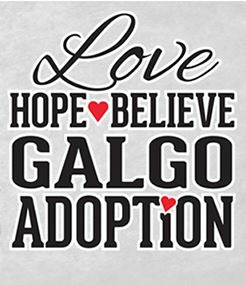About Galgos
“All that is necessary for evil to triumph is for good men to do nothing.” On the day Leena, our Galga, adopted through Magnificent Mutts, was no longer needed by her owner. She was to be hung from a tree as the tradition of the galgueros. On that day, evil was not going to win! A woman over heard what was about to happen and stepped in to save Leena’s life. The woman brought Leena to SOS Galgos in Barcelona Spain and that is where her journey to the US began. The woman in Spain most likely never thought about how that one single act of kindness would change the lives of so many people and in turn save many more galgos.
Love, Hope, Believe Galgo Adoption Inc.
Leena is one of the lucky ones, 45,000+ Galgos are killed every year in Spain. Galgos are hung from trees, dropped in abandoned wells, shot, set on fire or abandoned on the streets. LHB Galgo Adoption aim is to support the galgo rescues in Spain to end the cruel treatment of Galgos, find loving homes for rescued Galgos, and to bring light to the plight of the Galgos.
LOVE of the Galgos,
HOPE for their forever home,
BELIEVE in a better future for the Galgos.
The Galgo Español (Spanish Galgo) or Spanish greyhound is an ancient breed of dog, specifically a member of the sighthound family. Despite being called a "greyhound", the Spanish Galgo is not closely related to the (English) Greyhound, the lineages of the two breeds being different. However, for a short period in the 20th century, some breeders did cross-breed Galgos and Greyhounds in order to produce faster Galgos, specifically for track racing purposes.
History
The Galgo was named for the Gauls, a tribe of Celts, who inhabited the Iberian Peninsula 400–600 BC. The Galgo breed was probably a result of the dogs brought by the Celts on their migration through the peninsula mixed with dogs brought by traders who did business with the Celts. In the intervening centuries, it is likely that other sighthound breeds were interbred to produce the Galgo that we know today
Appearance
Galgos are similar in appearance to Greyhounds, but are distinctly different in their conformation. Galgos are higher in the rear than in the front, and have flatter muscling than a Greyhound, which is characteristic of endurance runners. They also tend to be smaller, lighter in build, have longer tails and have a very long, streamlined head that gives the impression of larger ears. Their chests are not as deep as a Greyhound's and should not reach the point of the elbow [1]
Unlike Greyhounds, Galgos come in two coat types: smooth and rough. The rough coat can provide extra protection from skin injuries while running in the field. They come in a variety of colors and coat patterns including solid colors (like black and red), brindle and parti-color (two colors or patterns together).
Temperament
Galgos have a very similar nature to Greyhounds. They are calm, quiet, gentle and laid back; happy to sleep their day away on their backs on a sofa. More than 90% of Galgos can be considered cat-friendly and are therefore an ideal choice for the hound lover who also owns cats. Almost all Galgos are also friendly towards other dogs and small dogs. Galgos are also very good with children, being calm in the house there is less risk of a child being knocked over or jumped on than a more excitable breed. They are very gentle and tolerate the often over-enthusiastic attentions of children with little risk of retaliation from the dog. Galgos have a very reserved personality and they have a tendency towards shyness, so it is very important that they be socialized early in life so that they grow up to be comfortable around strange people, dogs and locations.[1]
Health
Like many other sighthounds, Galgos are a fairly healthy breed although they are sensitive to anaesthesia. As such, proper care should be taken by the owner to ensure that the attending veterinarian is aware of this issue.
The article content of this page came from Wikipedia and is governed by CC-BY-SA.
